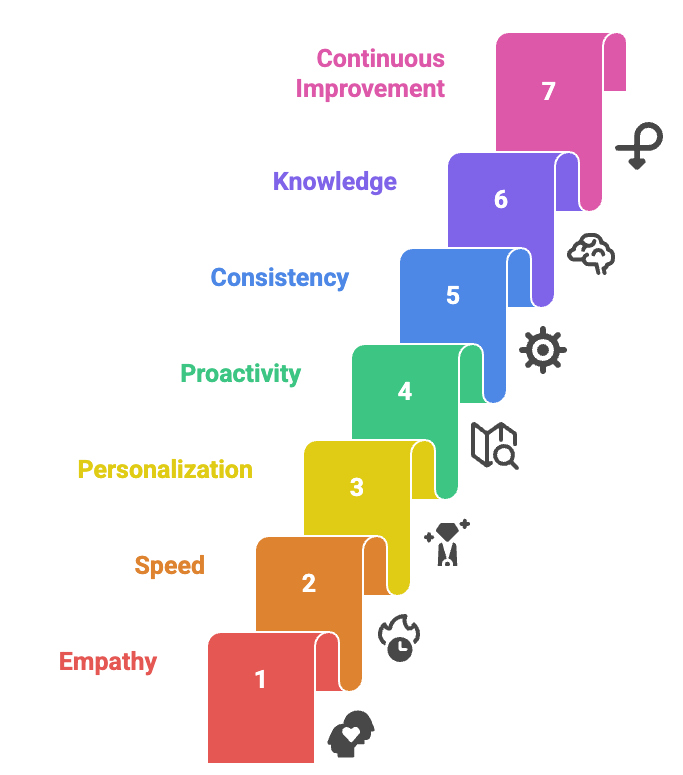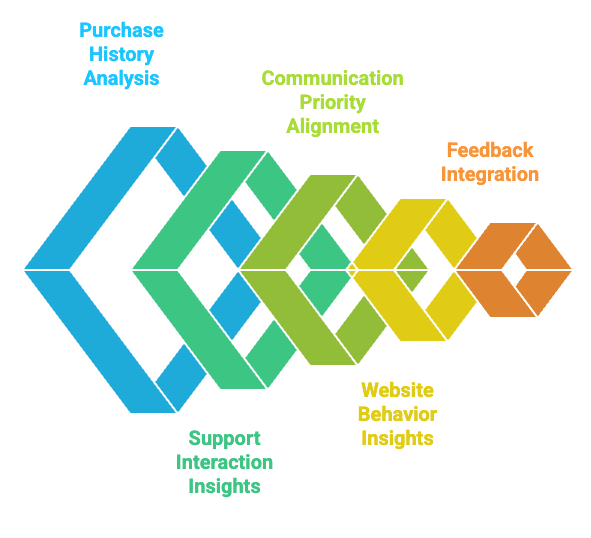7 Proven principles of customer care that actually work
Vaishali Jayaprakash
Sep 02, 2025

The numbers are shocking - 86% of customers stop doing business with the brands they trusted after only two poor customer experiences. This fact alone shows why understanding customer care basics isn't optional - it's crucial to stay in business.
Customer surveys paint an even clearer picture. The stakes are high, as customers would switch to a different brand that promises better service. These customer experience statistics prove why businesses need to excel at customer service to stay competitive.
Poor customer service hits companies where it hurts most - their profits. But, there are chances for few customers to look past a mistake if they've received excellent service before.
What separates companies that lose customers from those that build lasting relationships? The secret lies in giving customer service teams the right tools and skills.
What is customer care?
Customer care is about treating customers with kindness, respect and empathy to build emotional connections. It is beyond answering questions or fixing issues. True customer care involves listening closely to the customer, meeting their needs and delivering solutions that make them feel valued. This piece covers seven principles of customer care that really work and help turn everyday customer interactions into meaningful connections that build loyalty.

1. Empathy: Understand and connect with your customers
Customers reaching out to your business need more than just solutions- basically someone who understands them. Empathy is the core of exceptional customer care that sets outstanding service apart from average interactions.
Why empathy is the foundation of good customer service
Empathy means more than just feeling sorry for customers. It is basically knowing how to understand the other person's feelings by putting yourself in their shoes. While sympathy is just a feeling of sorrow for someone else’s misfortune, empathy creates real human connections.
Empathy makes a real difference in business success. The Empathy Index shows that the top 10 most empathetic companies grew twice as much in value compared to the bottom 10 and earned 50% more.
Empathy matters because:
- It builds trust and creates strong emotional bonds with customers
- It helps calm tense situations and soothes angry customers
- It confirms customer emotions so they feel heard and valued
- It guides better problem-solving as agents understand customer needs
Your bottom line benefits from empathy too. The CallMiner Churn Index reveals that 68% of consumers might leave after a poor call center experience, while 74% stay loyal after a good one.
How to train agents to show empathy
Your customer service team needs focused training and regular reinforcement to develop empathy. Here are proven ways to foster this essential skill:
- Practice active listening - Empathy starts with truly hearing your customers. Agents should have full attention on the customers, avoid interrupting, and focus on understanding them rather than responding. Active listening is basically summarizing concerns, asking questions, and acknowledging emotions.
- Implement role-playing exercises - Role playing with real-life scenarios on common customer interactions may help agents practice empathetic responses safely. These exercises help them find the right empathetic language for different situations.
- Teach personalization techniques - Your representatives should use customer names, mention previous interactions, and match the customer's emotional state. This shows customers they're individuals, not just numbers.
- Develop emotional intelligence - Agents need to spot emotional signs in all types of customer communication. They should recognize when customers feel frustrated, confused, or anxious. This skill matters even more with vulnerable customers.
- Encourage authentic communication - Scripts and templates serve a purpose, but too much reliance makes empathy feel fake. Let agents use their own voice and naturally adapt standard responses. Real empathy sounds genuine, not rehearsed.
- Recognize and reward empathetic behavior - Include empathy measurements alongside regular performance metrics. Some companies offer bonuses based on empathy scores. This shows how much your organization values empathy.
Empathetic communication- examples
Good empathy statements acknowledge emotions while showing you really want to help. Here are powerful examples for your team:
For validating feelings: "I understand how frustrating this must be for you." "That would frustrate me too." "I can see how this has been inconvenient for you." "You're right to be upset—let's work together to fix this."
For building rapport: "I would be asking exactly the same questions as you are." "I've had something like this happen before—I know how frustrating it can feel." "I can hear that this is important for you."
For taking ownership: "I'll work with our team here to resolve this." "I'm going to personally handle this for you." "Thank you for bringing this to our attention."
For reassurance: "I'm here to help!" "I appreciate your patience." "I'm truly sorry to hear about your experience."
Note that empathy must be genuine, not just about using the right phrases. Research shows that "empathy is how we relate to one another, and its authentic use can have a hugely positive effect". Customers stay loyal even during problems when they feel your genuine concern.
Your routine interactions become meaningful connections that build lasting customer relationships when you put empathy first in customer service.
2. Speed: Respond quickly without sacrificing quality
Speed plays a vital role in delivering exceptional customer service that affects your bottom line. Response time stands as one of the most important factors that lead to customer satisfaction.
Why response time matters
Your response time gives the first impression and sets the base for customer relationships. 90% of customers want an immediate response when they reach out for support. These expectations keep rising as instant messaging and social media become more common among customers.
Slow responses can destroy your business. Customers are four times more likely to abandon a company after poor service.
Your revenue stream takes a direct hit from response times. Studies show that 35-50% of sales go to the vendor that responds first. This makes speed your competitive advantage.
Tools to improve speed in customer service
Many customer support tools help your team respond faster without sacrificing quality:
- AI-powered chatbots - These chatbots handle routine questions 24/7 and cut the waiting time.
- Live chat platforms - Teams can talk to website visitors in real-time. Most of the support cases get solved through chat.
- Template systems - Ready-made answers for common questions can cut handle time. Agents can customize these templates while keeping responses consistent.
- Automated triage systems - These tools sort urgent issues and route routine questions to automated systems. This ensures critical matters get immediate attention.
- Self-service portals - U.S. customers expect companies to offer self-service support options. These portals let customers find answers on their own time.
- Response time tracking software - These tools watch reply times and notify teams about unanswered queries. This prevents customers from getting overlooked.
Balancing speed with accuracy
Quick responses shouldn't come at the cost of quality. Quality matters just as much as speed.
These proven strategies help maintain this balance:
Start with a tiered approach based on complexity. Sort customer issues by urgency and complexity. Give quick answers to simple problems and spend more time on complex cases.
Focus on First Contact Resolution (FCR). High FCR rates (70-80% is ideal) show both efficiency and competence. Your agents need detailed training. Automation handles basic questions, but consumers may still want human help for complex issues. Well-trained agents deliver both speed and quality. They know when to take their time and when to move quickly.
Track your performance metrics. Watch key indicators like First Response Time (FRT), Customer Satisfaction Score (CSAT), and Customer Effort Score (CES). These metrics show if faster responses actually make customers happier.
Most companies think they offer superior customer service, but only very few consumers agree. This gap shows why measuring what customers truly value matters so much.
3. Personalization: Make every interaction feel unique
Personalization is an essential principle of customer care in today's experience-driven marketplace. Research shows that 81% of customers prefer companies that offer customized experiences.
What is personalized customer service?
Personalized customer service is basically matching each customer's needs and priorities based on in-depth understanding of who they are. This approach is way beyond the reach of just using customer names—it creates unique, engaging experiences for everyone you serve.
Your business shows it values customers as individuals rather than transaction numbers through personalization. This customer-oriented approach shows real care for your unique needs of the customers and promotes stronger connections and trust.
Companies just need to provide customized experiences, according to 71% of customers.
Companies that shine at personalization gain competitive advantages. Customers who receive service that fits their specific situation feel understood and valued. This promotes brand loyalty and brings repeat business.
Using customer data to tailor responses
Great personalization starts with smart data collection and use. CRM systems and help desk software give service representatives access to valuable details like:

This information helps agents handle customer concerns better and faster. Companies should be clear about how they use customer data.
AI-powered analytics boost personalization by analyzing feedback and signals from different channels to understand customer feelings and needs. These tools help pick the content or experience that will best help customers move forward.
The best results come from mixing customer data with context awareness. Understanding where customers are in their experience helps solve potential issues before they become problems. This creates smooth experiences that feel natural instead of forced.
Avoiding robotic or scripted replies
Relying too much on scripted responses is one of the biggest personalization mistakes. Customers like customized interactions with empathy than scripted ones. Customers feel ignored and undervalued when representatives sound like they're reading from a script.
Cookie-cutter phrases like "We apologize sincerely for any inconvenience this may have caused" will sound fake and dismissive and not customized.
These approaches work better than rigid scripts:
- Provide guidance rather than scripts - Give representatives bullet points or loose phrases to guide conversations instead of long scripts.
- Train for authentic communication - Let agents use their own personality while covering all key points.
- Focus on empowerment - The core team should make decisions, improvise, and use good judgment instead of repeating the same memorized responses.
- Use specific acknowledgments - Replace generic phrases like "We apologize for any inconvenience" with real responses like "I'm sorry this happened to you. I'll look into it and get back to you by [specific date]".
Finding the sweet spot between consistency and personalization takes constant work. Quality control and consistency matter, but you can achieve these goals without scripting every interaction. Your team can build lasting customer relationships by making smart decisions and communicating naturally.
4. Proactivity: Solve problems before they arise
Your customer relationships can radically improve when you predict their needs. Smart businesses don't wait for problems. They spot and fix potential issues before customers notice them. This approach moves away from just solving problems to building stronger relationships.
What is proactive customer service?
Proactive customer service means taking care of customer needs before they surface. Your business takes the first step instead of waiting for customers to reach out. This includes fixing issues, sharing information, and offering solutions before customers ask.
Picture this: reactive service works like waiting for plants to wilt before watering them - damage already done. Proactive service stops problems before they start. Your customers save time and avoid frustration.
The business benefits are clear. Companies that embrace proactive service see several advantages:
- Lower support volume as teams tackle common issues early
- Better customer retention and lifetime value
- Staff can focus on complex cases more efficiently
- Better brand image through excellent customer care
Proactive service puts prevention first. Both customers and service teams enjoy a better experience.
Examples of proactive outreach
Businesses show proactive service in many ways. Here are some practical ideas you can use:
Timely notifications - customers can be alerted about shipping updates, issues in service, suspicious activity, or payment due dates. FedEx, to name just one example, sends real-time package tracking updates and notifies customers right away about delivery problems.
System health monitoring - Watch product performance to catch issues early. Netflix checks internet connections and adjusts video quality automatically to prevent buffering.
Predictive analytics - Study customer behavior to find at-risk customers before problems start. Square watches customer app activity and sends helpful emails when users struggle with tasks like bank account linking. This approach helped boost their CSAT scores from 30% to over 75%.
Educational outreach - Provide customers with the resources that help them get more value. This involves onboarding programs, knowledge base articles, and feature tutorials.
Tailored recommendations - Suggest products based on what customers buy or browse. Spotify suggests new music to their customers from their playlists and favourite artists based on their music preferences.
How automation can support proactive care
New technology makes proactive service easier and more effective. Automation helps scale these efforts:
AI systems analyze customer data to find patterns and predict issues. These tools use sentiment analysis to spot risks by finding frustration in customer messages. Teams can then focus on urgent cases first.
Chatbots work as front-line support and respond instantly to website visitors. They welcome users with custom messages, suggest products based on browsing history, and answer common questions during checkout. Customers get answers before they need to ask.
AI-powered predictive ticketing offers another great solution. It spots patterns in open cases and suggests fixes before customers complain. The system also flags unusual account activity or drops in product usage that might signal problems.
IoT devices help field service teams watch equipment performance from afar. They can predict failures and fix issues before they happen. Customers see less downtime and your dedication to their success.
These automated solutions let you deliver proactive service at scale without burning out your team.
5. Consistency: Deliver the same quality across all channels
Consistency is the unsung hero of customer service. It might not sound exciting, but it has incredible power to build lasting customer relationships. The world of customer service now has more channels and choices than ever. Businesses must provide reliable experiences at every touchpoint to succeed.
Why consistency builds trust
Customer trust grows from consistency. Human psychology explains why we want consistency.
As customers look for:

Consistency might not grab headlines, but it makes customers happy.
Omnichannel support and unified messaging
True omnichannel support creates seamless experiences. This approach goes beyond just offering multiple contact options. It connects all touchpoints while keeping the brand experience consistent.
Customer conversations should flow naturally between channels. A customer who starts on chat shouldn't repeat everything when they switch to phone. This smooth experience shows customers your business knows what it's doing. They'll trust that you can handle their concerns.
A single interface that brings together all communications is vital. This setup helps your brand stand out in a busy market. Your support team gets the full picture of each customer's story. They solve problems faster and customers feel less frustrated.
Training for consistent tone and service
Teams need detailed training programs to deliver consistency across channels. Standard Operating Procedures (SOPs) help agents follow shared processes. These procedures spell out steps, tone, and ways to handle tough situations.
Good training sets clear expectations for customers and support teams alike. Everyone should know what good service looks like. Regular training helps both new and experienced team members maintain brand standards.
All the same, consistency doesn't mean robots reading scripts. Teams need a framework to provide real, human service while meeting quality standards. The best companies know their people build the most important relationships. They create a service-minded culture from within. Their teams take initiative, solve problems, and go beyond expectations. This approach turns regular customers into brand champions.
6. Knowledge: Equip your team with the right information
Knowledge is the life-blood of exceptional customer service. Even the most empathetic agents can't solve problems without proper information. Today's complex product environments make it essential to give your team complete knowledge about your products and services.
The role of product knowledge in customer care
Product knowledge means more than just listing features—it shows how deeply your team understands what customers get from your company. This complete understanding strengthens your support team in several ways:
- Builds customer confidence and trust - Agents who know their products speak with authority that customers notice, which creates credibility
- Makes issue resolution faster - Teams with deep product knowledge fix problems more quickly, which cuts down customer frustration and boosts satisfaction scores
- Drives additional revenue - Knowledgeable agents spot complementary products that help customers and boost sales
- Improves brand reputation - Expertise makes your entire organization look better and strengthens your market position
Quality depends on representatives who provide accurate, solution-focused help—something impossible without thorough product knowledge.
Creating and maintaining a knowledge base
A well-laid-out knowledge base forms the foundation of customer service knowledge management. This central hub contains everything from user guides and troubleshooting steps to FAQs and internal policies.
Your knowledge base works best when you:
Start with intuitive organization using categories that help users find information quickly. To cite an instance, grouping related articles under clear headings like "Email Reporting" makes navigation smooth.
Quality control comes next through dedicated reviewers who check accuracy before publishing. This step ensures your customers and team only see high-quality, verified information.
Each article needs unique identifiers that make them easy to reference for customers and support agents. Regular content updates reflect product changes and keep everything relevant.
Most organizations find that knowledge base software substantially improves their capabilities. Tools like Zendesk and Helpjuice help teams create, manage, and share information quickly while offering powerful search features.
Real-time support tools for agents
Real-time assistance tools have changed how agents get information during customer conversations. AI-powered platforms look at conversations as they happen and offer instant suggestions automatically.
These systems bring several benefits:
Response times drop because agents get instant information when they need it most. Quick access lets support teams handle client questions faster and cut wait times.
Sentiment analysis helps agents handle emotional situations with the right level of empathy. This leads to better communication and happier customers.
Making knowledge your customer care priority creates a strong base for all other service elements. Agents with the right tools don't just fix problems—they build relationships that turn customers into loyal brand promoters.
7. Continuous improvement: Learn and evolve from feedback
These proven customer care principles change ordinary service interactions into meaningful relationships that accelerate business growth. These principles work together - empathy builds emotional connections, speed shows respect for customer's time, customized service demonstrates individual value, proactivity prevents issues, consistency builds trust, and knowledge enables your team to deliver exceptional service.
Note that customer expectations keep rising. Your dedication to these principles must adapt to changing needs and technologies. Top companies don't see customer service as just a department - it's a philosophy that spreads through their entire organization.
The financial effect is clear. Companies that use these principles see higher retention rates, increased customer lifetime value, and stronger brand advocacy. Companies that ignore these basics risk losing billions each year through poor service experiences.
These principles need investment and organizational commitment, but poor service costs more. This makes excellent service both good practice and smart business.
Your first step should be evaluating your current customer service approach against these core principles. Look for gaps, focus on improvements, and give your team the tools and training they need. Simple changes often create remarkable results when used consistently across customer touchpoints.
Exceptional customer care comes from seeing service through your customer's eyes. Understanding their needs, quick personal responses, problem prevention, consistent service, and a knowledgeable team create experiences that keep customers loyal. These principles may look simple, but using them consistently separates successful businesses from struggling ones in today's customer-focused market.
Key takeaways on principles of customer care
Research shows that great customer service directly affects your profits. Your customers care about their experience just as much as your products or services - 88% of them to be exact. Companies that master these principles gain a real edge over their competition.
The principles create a complete system that works together. Your emotional connection grows through empathy. Quick responses show you value customer time. Personal attention proves you care about each customer. Taking action before problems occur prevents issues. Trust builds through consistent service. Knowledge helps solve problems faster. Your service keeps getting better by adapting to new customer needs.
These basic principles lead to clear business results:
- Customer retention improves
- Brand loyalty grows
- Revenue increases
- Brand reputation strengthens
Successful companies know that customer service goes beyond just one department. They make it part of their entire culture. Their teams can take action, fix problems, and create experiences that turn regular customers into passionate supporters.
These seven principles of customer care form the foundation of truly effective service. Your service will not just meet expectations - it will exceed them, stand out, and stimulate long-term business growth when you apply these principles across every customer interaction.
Quick Summary: 7 Proven Principles of Customer Care
Customer care goes beyond solving problems—it’s about empathy, respect, and building emotional connections that create lasting loyalty. Research shows poor service can cause up to 86% of customers to leave after just two bad experiences, proving why strong customer care is essential for business success.
The 7 Principles of Customer Care:
- Empathy – Understand customer feelings, validate emotions, and build trust through genuine concern.
- Speed – Respond quickly without losing accuracy; use automation, live chat, and clear FRT/FCR standards.
- Personalization – Tailor every interaction using customer history, data, and authentic communication.
- Proactivity – Solve issues before they arise with predictive tools, notifications, and educational outreach.
- Consistency – Deliver the same quality experience across all channels through omnichannel support and SOPs.
- Knowledge – Equip teams with deep product understanding and strong knowledge bases for fast, confident help.
- Continuous Improvement – Adapt with feedback loops, training, and evolving strategies to keep service ahead of rising expectations.
Key Takeaway:
When practiced together, these principles transform everyday interactions into memorable experiences that drive retention, loyalty, and revenue growth. Companies that excel at customer care turn service into a culture—not just a department.
Frequently Asked Questions
Customer care is basically treating customers with respect and empathy to build emotional connections. It is beyond answering questions, building lasting relationships.
The seven core principles of customer care are empathy, speed, personalization, proactivity, consistency, knowledge, and continuous improvement. These principles work together to create meaningful customer experiences that drive loyalty and business growth.
Empathy is one of the most important principles of customer care as it helps build trust, diffuse tense situations, and lead to more effective problem-solving. Companies that prioritize empathy in their customer interactions often see increased customer loyalty and higher earnings.
The 5Cs of customer service are:
- Culture
- Compensation
- Communication
- Compassion
- Care
Personalization is essential in modern customer care, as customers prefer companies that offer personalized experiences. It involves tailoring interactions to match individual needs and preferences, making customers feel valued and understood, which fosters brand loyalty.
